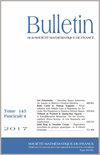Diversité des Arthropodes de sous-bois des forêts sèches de Madagascar
IF 0.6
4区 数学
Q3 MATHEMATICS
引用次数: 0
Abstract
Diversity of understory arthropods in the dry forests of Madagascar. The arthropods of Madagascar are among the most poorly known animal groups on the island. The principal objective of this study was to determine the diversity of this group at three different localities in lowland dry forests of western Madagascar. The three sites, all inventoried during the dry season in 2017, include: the Ankarafantsika National Park (16°18’S, annual rainfall: 867 mm) in the northwest; the forest of the Centre National de Formation, d’Études et de Recherches en Environnement et Forestier (CNFEREF) at Kirindy (20°04’S, annual rainfall: 555 mm) in the central west; and the Tsimanampesotse National Park (24°01’S, annual rainfall: 334 mm) in the extreme southwest. Malaise and pit-fall traps were used to capture arthropods and 24 orders belonging to 133 families were identified. The community at Ankarafantsika was the most diverse with 19 orders and 89 families with a more balanced taxonomic representation, while Tsimanampesotse had 18 orders and 69 families and Kirindy CNFEREF had 17 orders and 70 families. Calculated similarity between the different sites at the family level was relatively high, while that at the order level relatively low even given a certain level of homogeneity was noted between the three localities. The composition of arthropods in the dry forests of Madagascar varies according to local conditions, which include bioclimatic factors, and the characteristics of the vegetation at the three localities.马达加斯加干燥森林林下节肢动物的多样性
马达加斯加干林林下节肢动物的多样性。马达加斯加的节肢动物是该岛上最不为人知的动物群体之一。本研究的主要目的是确定在马达加斯加西部低地干燥森林的三个不同地点的这一群体的多样性。这三个地点均在2017年旱季进行了调查,包括:西北部的安卡拉凡特西卡国家公园(16°18'S,年降雨量:867毫米);中部西部国家林业研究中心(National de Formation, d ' Études et de research en environmental et foretier, CNFEREF)位于Kirindy的森林(20°04'S,年降雨量:555 mm);以及西南方的Tsimanampesotse国家公园(24°01'S,年降雨量334毫米)。采用诱虫法和陷阱法捕获节肢动物,共鉴定出节肢动物133科24目。Ankarafantsika的群落最多样化,有19目89科,分类代表较为均衡,Tsimanampesotse有18目69科,Kirindy CNFEREF有17目70科。不同地点在科级水平上的相似性较高,而在目级水平上的相似性较低,尽管三个地点之间存在一定的同质性。马达加斯加干燥森林节肢动物的组成因当地的生物气候因素和三个地区的植被特征而异。
本文章由计算机程序翻译,如有差异,请以英文原文为准。
求助全文
约1分钟内获得全文
求助全文
来源期刊
CiteScore
0.90
自引率
0.00%
发文量
0
审稿时长
>12 weeks
期刊介绍:
The Bulletin de la Société Mathématique de France was founded in 1873, and it has published works by some of the most prestigious mathematicians, including for example H. Poincaré, E. Borel, E. Cartan, A. Grothendieck and J. Leray. It continues to be a journal of the highest mathematical quality, using a rigorous refereeing process, as well as a discerning selection procedure. Its editorial board members have diverse specializations in mathematics, ensuring that articles in all areas of mathematics are considered. Promising work by young authors is encouraged.

 求助内容:
求助内容: 应助结果提醒方式:
应助结果提醒方式:


